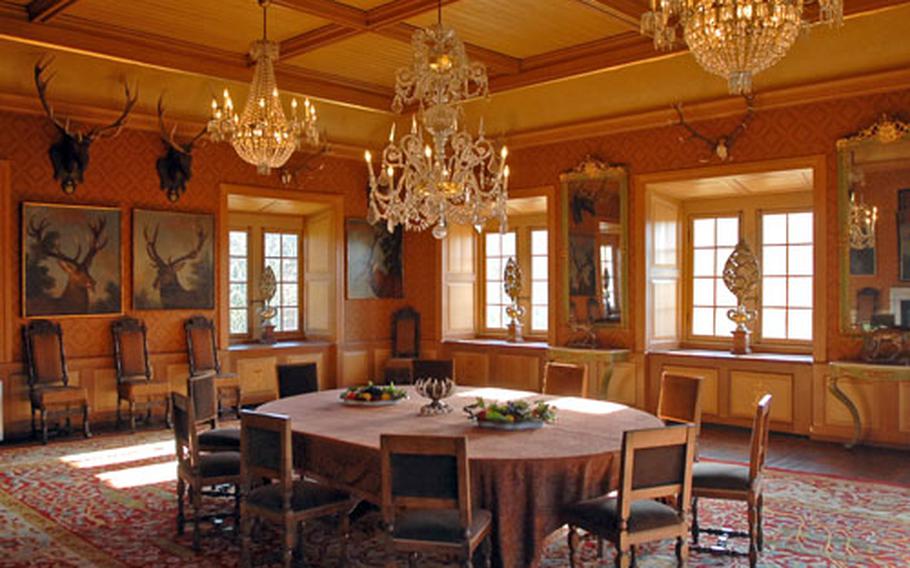
Furnishings in the Hirschsaal, or Stag Hall, of the 16th-century Jagdschloss Kranichstein, are from the 17th through 19th centuries. The former ducal hunting lodge is now a museum. (Michael Abrams / S&S)
Hunting has been around as long as mankind has roamed the Earth. Whether with spears in the Stone Age, crossbows in the Middle Ages, or today’s shotguns and rifles, man has been stalking game.
For a long time, man hunted to survive, but from the Middle Ages on in most of Europe, hunting was a privilege of nobility. They owned the forests and meadows where the game grazed. Hunting was a major pastime, a cultural and social event. And where better to enjoy pre- and post-hunting activities than at a hunting lodge?
The Jagdschloss Kranichstein, on the outskirts of Darmstadt, Germany, was one such lodge. But as the name suggests — Schloss means castle or palace in German — this one was much grander than a cabin in the forest.
Built in the late 16th century under Count George I of Hessen- Darmstadt, an avid hunter, the Jagdschloss is a three-wing Renaissance structure sitting amid a park and surrounded by a forest.
For nearly 350 years, the house of Hessen-Darmstadt went to Kranichstein to hunt.
It was the last grand duke, Ernst Ludwig, who established a museum dedicated to hunting there in 1917. After World War II, a Hessian hunters foundation took over the building, and it was renovated at the end of the last century.
Today, one wing is a luxury hotel and restaurant, while the other two house the museum, a hall used for cultural events and a chapel.
The ground floor of the museum traces the history of hunting from prehistoric times to today, with the focus on the period when the lodge was used for hunting. Large panels with photos, drawings and text — in German, English and French — explain how hunting evolved from a necessity for all to a privilege for some and a hobby for many.
At the far end of the ground floor is the grand dukes’ impressive hunting weapons collection that spans nearly four centuries. There is a fine selection of crossbows, used into the late Middles Ages because they were more accurate than guns at the time.
The gun collection includes matchlocks, wheel locks, flintlocks and breechloaders. The most interesting weapons are the 18th-century pump-up air guns. Accurate enough to kill a deer at a distance of 200 feet, the guns were popular with poachers because they were silent. Thus they were often banned to all except nobility.
The upper floor of the museum is made up of rooms branching off two long hallways. These, known as the big and small stag way, are adorned with hunting trophies and art with hunting themes. The rooms are decorated with furniture, art and tapestries from the lodge’s different periods.
The walled gardens are open the same hours as the museum, but the surrounding fields and forests, where once only the grand dukes and their guests could hunt, can be explored any time.
On the QT
Directions: The museum is in the northeast corner of Darmstadt, in the Kranichstein quarter of the city. Exit Autobahn 5 at Weiterstadt and take highway B-42 toward Darmstadt. Follow signs toward Rödermark and Kranichstein and then to Jagdschloss Kranichstein.
Times: From Nov. 1 to March 31, the museum is open 2-5 p.m. Wednesday to Saturday and 10 a.m. to 5 p.m. Sunday and on German holidays; from April 1 to Oct. 31, it is open 1-6 p.m. Wednesday through Saturday, and 10 a.m. to 6 p.m. on Sunday and holidays
Costs: Admission is 2.70 euros for adults, 1.60 euros for children.
Food: The hotel at the Jagdschloss has two restaurants. The Jagdschloss-Schänke is open noon to 6:30 p.m. Tuesday through Saturday and 2:30-5:30 p.m. Sunday. While on the expensive side, it does have affordable meals. In the evening, the Landgraf Ludwig VIII restaurant offers fine (expensive) dining from 7 p.m. to midnight. There are various cheaper restaurants in Kranichstein proper.
Info: Visit the German-only Web site for Jagdschloss Kranichstein.
— Michael Abrams